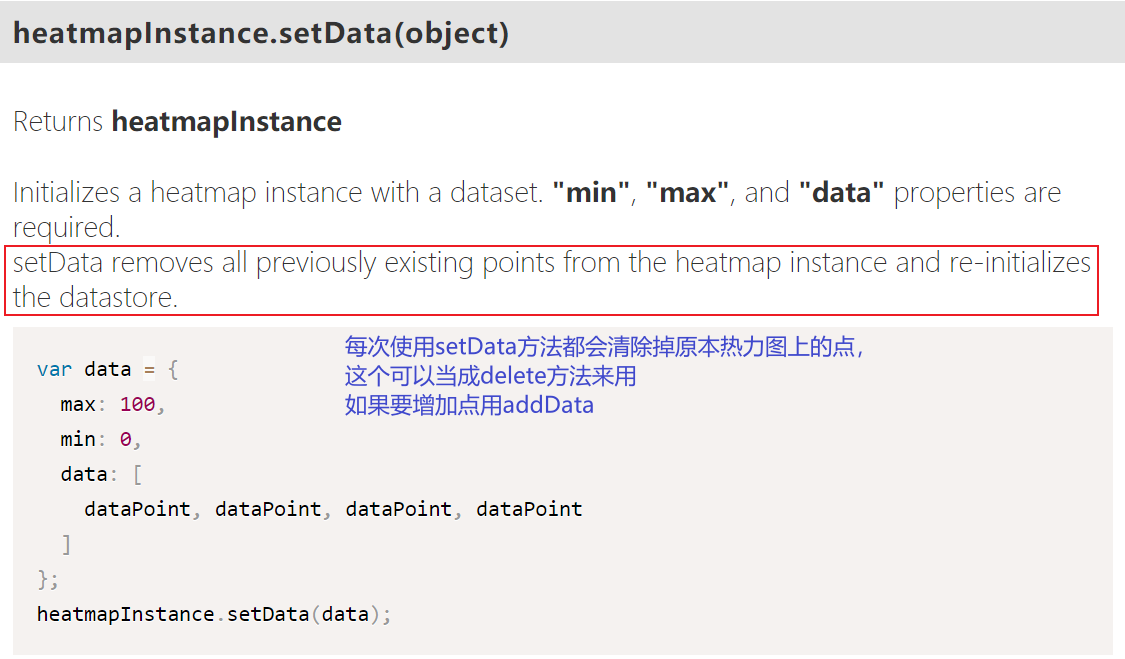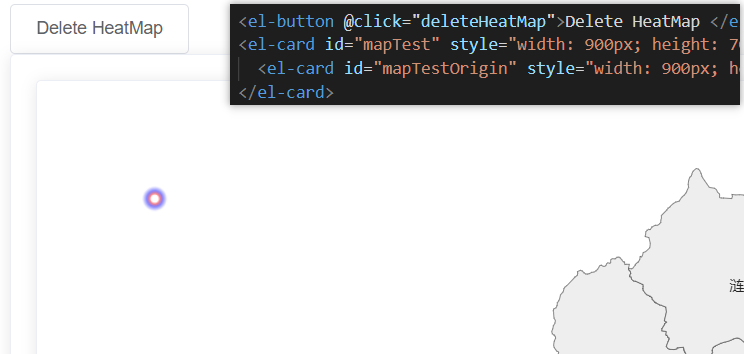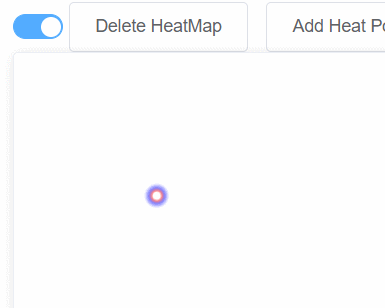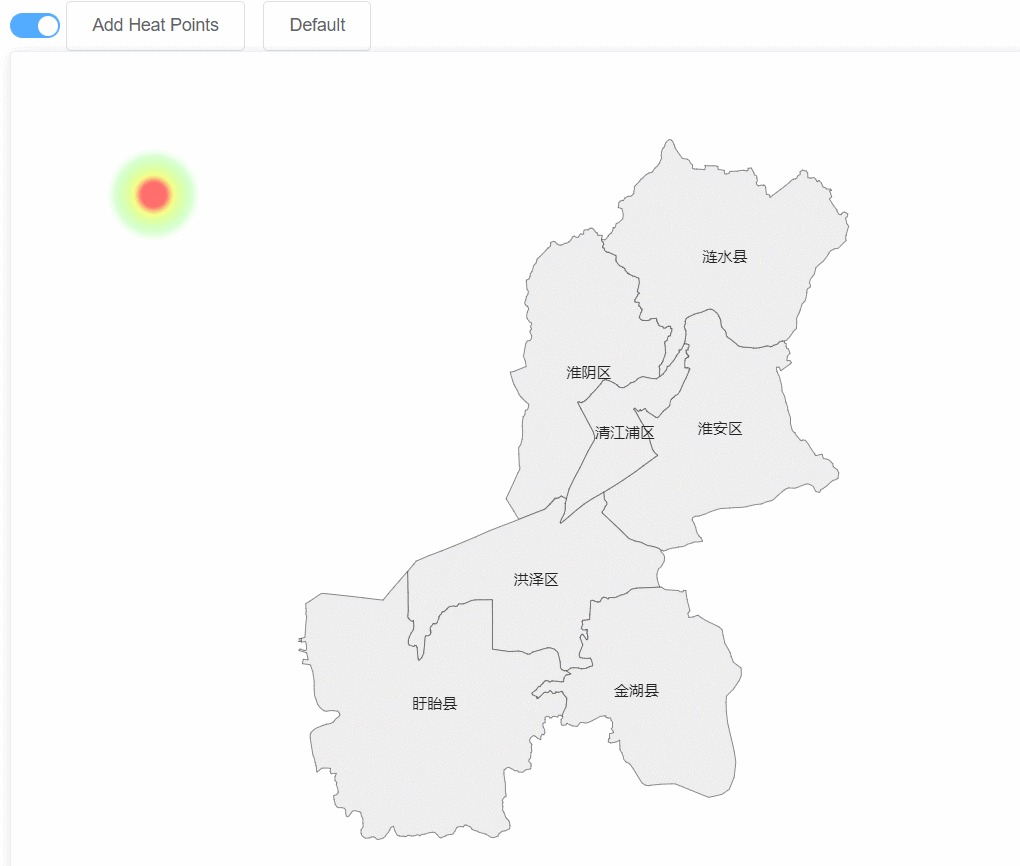0.相关网站
官网文档——heatmap.js Documentation (patrick-wied.at)
一个写的很好的示例——Vue+heatmap.js实现热力图的展示 - 简书 (jianshu.com)
1.安装
npm install heatmap.js
2.引用
// 在需要的文件中引入
// h337是官网用的写法,我就照着这个来了
import h337 from "heatmap.js";
3.使用

data() { return { heapMapIns: null, pointsArr: [{ x: 115, y: 115, value: 1000 }], }; }, mounted() { window.onresize = () => { this.myChart.resize(); }; this.drawMap(); this.initHeatMapOrigin(); }, // Methods initHeatMapOrigin() { // create configuration object let config = { container: document.getElementById("mapTest"), radius: 10, maxOpacity: 0.5, minOpacity: 0, blur: 0.75, gradient: { // enter n keys between 0 and 1 here // for gradient color customization ".5": "blue", ".8": "red", ".95": "white", }, }; // create heatmap with configuration this.heapMapIns = h337.create(config); // a single datapoint let point = { x: 150, // x coordinate of the datapoint, number y: 215, // y coordinate of the datapoint, number value: 500, // the value at datapoint(x, y) }; let dataPoint = point; this.heapMapIns.addData(dataPoint); // multiple datapoint // (for data initialization use setData!!) this.heapMapIns.addData(this.pointsArr); },
4.注意要点

// DELETE HeatMap
deleteHeatMap() {
let data = {
max: 100,
min: 0,
data: [],
};
this.heapMapIns.setData(data);
console.log("Delete heatMap");
},
然后是关于层级的问题,一开始我犯了个错误,把地图层和热力图层作为两个同级元素,结果堆在1起总是有一个被挡住。后来就想到把热力图放在父亲层,地图放在子层,这样就可以用了。

还有关于addData和setData区别,setData是初始化热力图用的,addData是后续增加点用的。两者接收参数也不同,setData只能接收对象,addData对象和数组都可以。
只要数据改动addData,就可以在图像上显示。如果设定了MAX与MIN,记得后续加点也要用setData!!!不然初次渲染的没有高度!!!

关于初始化setData时候的报错,也是上面这个原因,注意传参值。



还有关于保存初始值深浅拷贝的问题,见下一篇随笔。
5.测试项目
老规矩先上代码

<template>
<div>
<el-switch v-model="isShow" inactive-color="#666" active-color="#53acff">
</el-switch>
<el-button @click="addHeatPoints">Add Heat Points </el-button>
<el-button @click="backDefault">Default </el-button>
<div id="mapTest" style=" 900px; height: 700px">
<el-card id="mapTestOrigin" style=" 900px; height: 700px"></el-card>
</div>
</div>
</template>
<script>
import * as echarts from "echarts";
import h337 from "heatmap.js";
// import * from "heatMap";
export default {
data() {
return {
heatMapIns: null,
// Default Setting
pointsArrO: [],
pointsArr: [{ x: 115, y: 115, value: 1000 }],
isShow: true,
};
},
watch: {
isShow() {
// When isShow is true, heatMap can be seen.
// Otherwise, the heapPoints will remove from the map.
if (this.isShow) {
let dataFormatter = {
// Max and min data compare to show the heapMap color.
max: 1000,
min: 0,
data: this.pointsArr,
};
// this.pointsArr.forEach((key) => {
// console.log("VALUE", key.value);
// });
// A sentence is equal to B.
// A.
// this.heatMapIns.setData(dataFormatter);
// B.
this.heatMapIns.addData(this.pointsArr);
} else {
this.deleteHeatMap();
}
},
},
mounted() {
window.onresize = () => {
this.myChart.resize();
};
this.pointsArrO = this.getDefaultPoints(this.pointsArrO, this.pointsArr);
this.drawMap();
this.initHeatMap();
},
methods: {
// get Default heapPoints
// Remember arrGet need to be returned as new Arr.
// Otherwise it only make effect in this function scope.
getDefaultPoints(arrGet, arrFrom) {
// Complex data type needs DEEP COPY.
arrGet = JSON.parse(JSON.stringify(arrFrom));
// arrGet = deepclone(arrFrom);
// console.log("Default Origin Arr Length", arrGet.length);
return arrGet;
// arrGet = JSON.parse(JSON.stringify(arrFrom));
// deepclone function is same to the string upper.
function deepclone(obj) {
console.log("BEFORE DEEP CLONE", obj.length);
let _obj = JSON.stringify(obj);
let cloneObj = JSON.parse(_obj);
console.log("AFTER DEEP CLONE", cloneObj.length);
return cloneObj;
}
},
// Go back to default setting
backDefault() {
this.pointsArr = this.getDefaultPoints(this.pointsArr, this.pointsArrO);
console.log("Lenght", this.pointsArrO.length, this.pointsArr.length);
let dataFormatter = {
max: 1000,
min: 0,
data: this.pointsArr,
};
this.heatMapIns.setData(dataFormatter);
},
clearCanvas() {
var c = document.getElementById("mapTest");
var cxt = c.getContext("2d");
cxt.fillStyle = "#000000";
cxt.beginPath();
cxt.fillRect(0, 0, c.width, c.height);
cxt.closePath();
},
// Add the heat points
// First add the points. need to paint the MAX and MIN!!!
addHeatPoints() {
for (let i = 0; i < 10; i++) {
let tX = getRandomInt(0, 900);
let tY = getRandomInt(0, 700);
let tV = getRandomInt(100, 1000);
this.pointsArr.push({ x: tX, y: tY, value: tV });
// console.log("Temp", tX, tY, tV);
}
let dataFormatter = {
// Max and min data compare to show the heapMap color.
max: 1000,
min: 0,
data: this.pointsArr,
};
this.heatMapIns.setData(dataFormatter);
// Get random number
function getRandomInt(min, max) {
return Math.floor(Math.random() * (max - min + 1)) + min;
}
},
// DELETE HeatMap
deleteHeatMap() {
let dataFormatter = {
max: 1000,
min: 0,
data: [],
};
// this.clearCanvas();
this.heatMapIns.setData(dataFormatter);
// this.heatMapIns.repaint();
console.log("Delete heatMap");
},
initHeatMap() {
// Everytime repaint need to delete the last heatmap
// this.deleteHeatMap();
let self = this;
this.heatMapIns = h337.create({
container: document.getElementById("mapTest"),
gradient: {
//渐变颜色
0: "rgba(255,255,255,1)", //value为0的颜色
0.3: "#82ff6d", //value为500的颜色
0.8: "#f3ff6d", //value为1000的颜色
1: "#ff6d6d", //value为2000的颜色
},
maxOpacity: 1,
minOpacity: 0,
blur: 0.75,
});
let dataFormatter = {
// Max and min data compare to show the heapMap color.
max: 1000,
min: 0,
data: self.pointsArr,
};
this.heatMapIns.setData(dataFormatter);
},
drawMap() {
if (
this.myChart != null &&
this.myChart != "" &&
this.myChart != undefined
) {
this.myChart.dispose();
}
this.$nextTick(() => {
// let self = this;
this.myChart = echarts.init(document.getElementById("mapTestOrigin"));
// HuaiAn
let geoJson = "http://localhost:8080/static/mapHuaiAn.geoJson";
// Axios---
this.get(geoJson)
.then((res) => {
echarts.registerMap("HuaiAn", res);
this.myChart.setOption({
series: [
{
type: "map",
map: "HuaiAn",
label: {
show: true,
color: "#222",
},
},
],
});
})
.catch((err) => {
console.log("ERR", err);
});
});
},
},
};
</script>
<style>
</style>
效果如图

